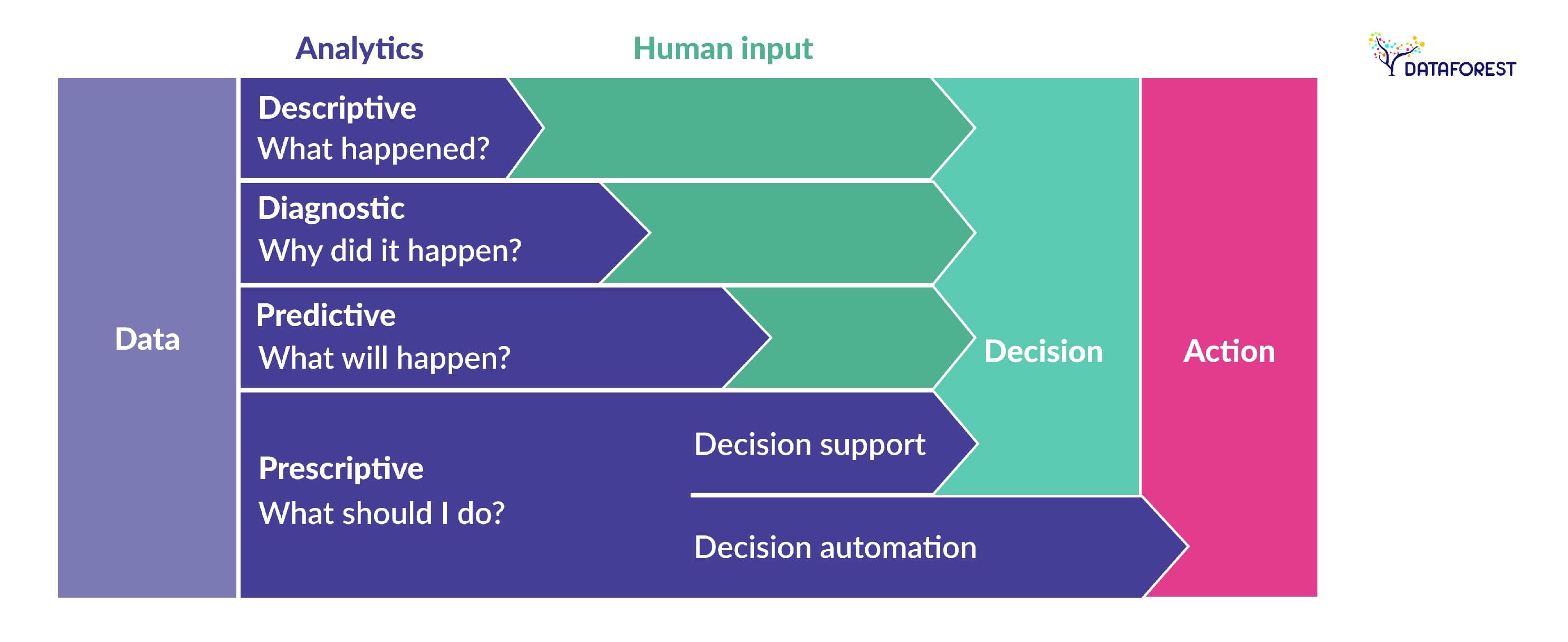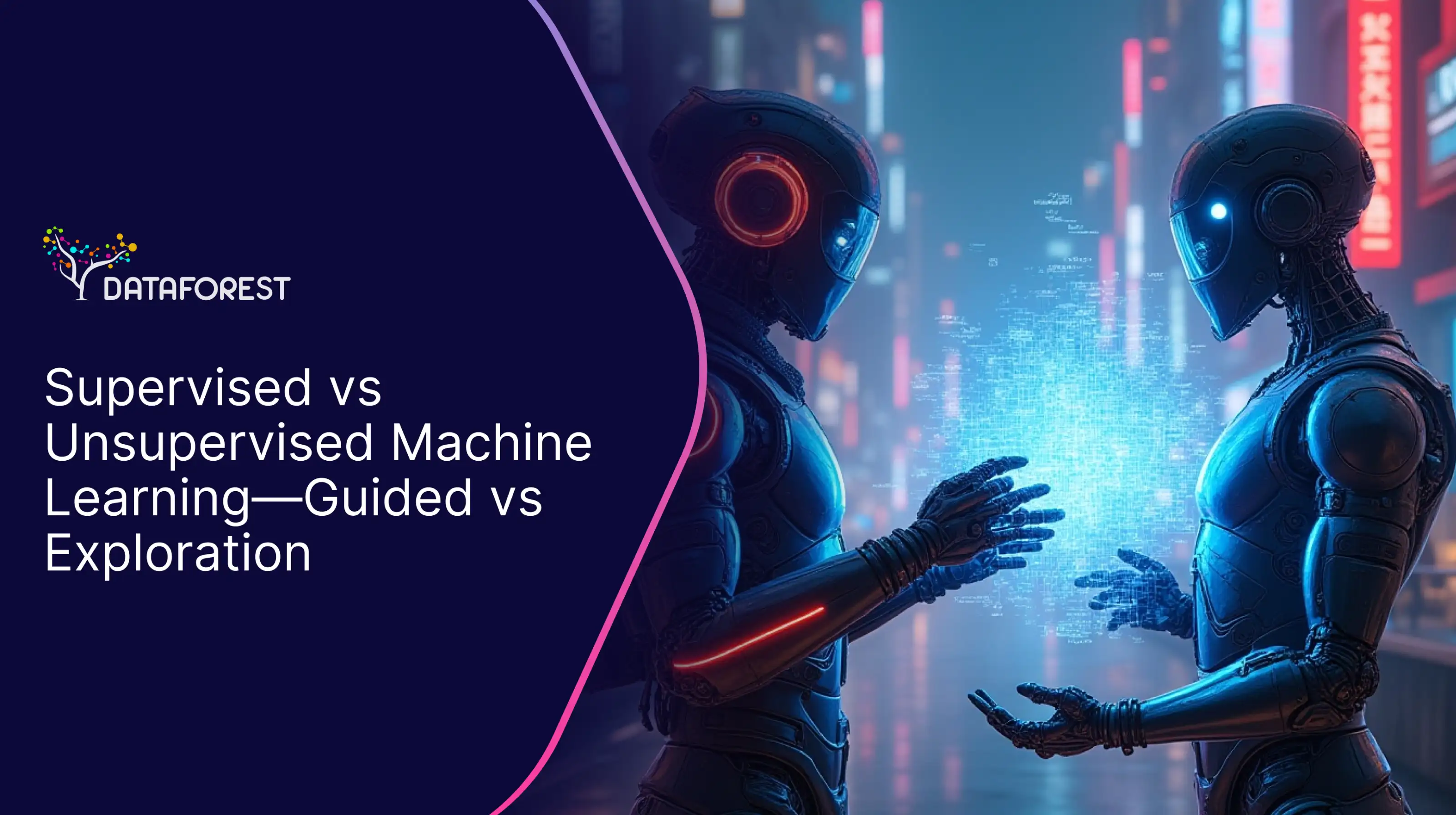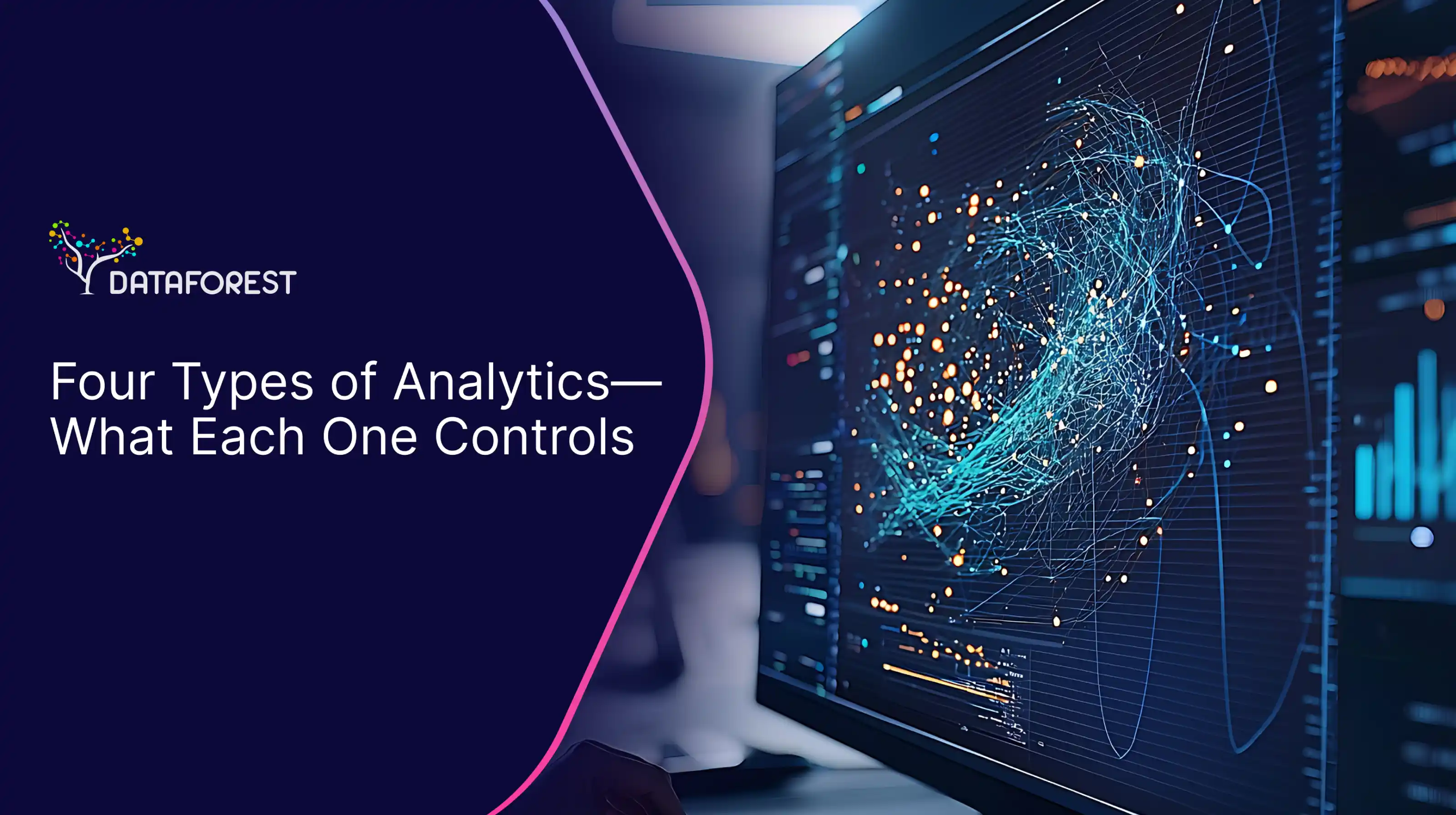You're a sneaker company wanting to up your game. With Descriptive Analytics, you analyze past sales to see which shoe models flew off the shelves last year. Predictive Analytics says, "Hey, based on these trends, low-top sneakers with vibrant colors are likely to be the next big thing." With Social Media Analytics, check out what people post about; if neon sneakers are all the rage on Instagram, you know you're onto something. Bring in Machine Learning. Train your system to understand customers. If Sarah always buys bright sneakers, the system suggests, "How about these new neon low-tops?" And these are only some of the benefits of different types of data science that help businesses.

Descriptive Data Science — The Future in the Past
Descriptive data science steps into the limelight for a simple reason: to shed light on what happened in the past. It's the historian among types of data science, capturing the essence of events, trends, and occurrences. If you are interested in this topic, please arrange a call—we will explain everything in detail.
Defining the Star of the Show
Descriptive data science is the storyteller that narrates the tale hidden within your data. Its primary goal is to paint a vivid picture of historical data, answering the question, "What's been going on?" Think of it as the first chapter in the book of types of data science, setting the foundation for deeper exploration.
Summarizing and Visualizing the Story
Imagine you've got this treasure trove of data — sales figures, user interactions, whatever floats your data boat. In types of data science, descriptive one involves summarizing the data, like turning a whole novel into a synopsis. It's about distilling the essence, crunching numbers to give you averages, totals, and percentages. But hold on, it's not just about numbers. Graphs, charts, and dashboards become the canvas. Want to see how your sales spiked during the holidays? A well-crafted bar chart will tell that story better than a thousand numbers.
Spotlight on Applications
In retail, descriptive data science helps track product sales over time, highlighting peak seasons. For a website, it might summarize user interactions, revealing which features are getting the most clicks. It could break down expenditure categories in finance, showcasing where the money flows. Take a weather app, for instance. Have you ever noticed those colorful graphs showing temperature trends? That's descriptive data science as a type of data science part.
The Detective Work of Diagnostic Data Science
Diagnostic data science is the investigator, one of the types of data science, peeling back the layers of data to expose the 'why' behind the numbers. We can consider your case; just schedule a call.
It Needs Only Three Things to Consider
- The Reason: Diagnostic data science is the detective in the types of data science world, searching for clues and understanding the reasons driving specific outcomes.
- The Definition: Diagnostic data science aims to dig deeper and go beyond the surface, providing insights into the factors influencing specific events.
- 'How' and 'why': Diagnostic data science identifies patterns that led to a spike in sales, anomalies that hint at irregularities, and causes behind unexpected shifts in user behavior.
Examples in the Real World
- In healthcare, diagnostic data science investigates patient outcomes, identifying patterns in treatment responses or anomalies that point to potential issues. Different types of data science can complement the results.
- For a cybersecurity team, it could mean dissecting network logs to uncover the cause of a breach. Is it a pattern of unusual activities, a specific vulnerability, or an insider threat?
- Even in manufacturing, if there's a sudden increase in product defects, diagnostic data science is one of the types of data science steps to find the root cause – whether it's a flaw in the process.
The Purpose of Predictive Data Science
Businesses navigate uncertainty with foresight by developing models and algorithms capable of learning from historical big data. Whether it's different from other types of data science, predicting customer preferences, stock market trends, or disease outbreaks, the goal is to empower decision-makers with insights.
How Predictive Data Science Works
- Statistics is all about deciphering patterns from historical data. Predictive data science distills the essence of past occurrences by analyzing trends, correlations, and variations. For types of data science, it's like understanding the rhythm of a song — once you've got the beat, you can predict where the melody might lead.
- Machine learning is where predictive data science gets futuristic. Using algorithms that can adapt and learn from data, it's like having a digital apprentice. The machine learning wand takes historical patterns and learns to recognize them, creating models that can generalize from the past to predict the future with types of data science.
- You have a dataset filled with variables: customer preferences, market trends, or health indicators. Predictive algorithms are skilled dancers interpreting these variables' movements in a type of data science dance. They learn the steps and refine their routine, and when the music changes (new data comes in), they seamlessly adapt their dance to make predictions.
Real-world Enchantments
- In finance, predictive data science works its magic for stock price forecasting. It predicts potential future movements, helping investors make informed decisions.
- Predictive models forecast patient readmission rates in healthcare based on factors like medical history and treatment outcomes.
- In energy, predictive data science is one of the types of data science that forecasts electricity consumption patterns, helping utility companies optimize power generation and distribution.
- In retail, it's the force behind personalized recommendations. Have you ever wondered how your favorite online store suggests products you like? It is a type of data science work.
The Wisdom of Prescriptive Data Science
Prescriptive data science, as a part of types of data science, steps into the scene as the guiding hand, offering predictions and actionable recommendations. Unlike its predictive counterpart, prescriptive data science doesn't stop at forecasting what might happen. Analyzing data and understanding causal relationships offers informed suggestions on what actions would optimize a given situation.
- Imagine you're an e-commerce tycoon. Predictive data science might tell you that a specific product is likely to be a hit next month. Now, enter prescriptive data science as one of the types of data science. It advises you on the best marketing channels, pricing strategies, and even the optimal time to launch a campaign for maximum impact.
- In healthcare, if predictive data science forecasts a potential increase in patient admission, prescriptive data science recommends resource allocation strategies, suggesting the most efficient use of staff and facilities to handle the anticipated influx.
- In energy management, if predictive analysis indicates an upcoming surge in electricity demand, prescriptive data science proposes the most cost-effective methods to ramp up power generation and distribution, ensuring a seamless response.
Prescriptive data science is knowing what to do with info. This is its difference from other types of data science.
The Essence of Causal Data Science
Causal data science is also a part of data science and seeks not just correlations but the holy grail of cause and effect. Its significance lies in unraveling the intricate web of relationships between variables, moving beyond mere associations to understand the valid drivers of outcomes. Unlike counterparts, causal data science is on a mission. Its aim is to establish connections and the 'why' behind them.
Examples of Causal Revelations
- In healthcare, it might investigate whether a new treatment caused improved patient outcomes or whether other variables played a role.
- In education, a causal study as a display of types of data science might reveal that smaller class sizes directly lead to improved student performance, influencing policies and resource allocation.
- In environmental science, causal analysis might pinpoint specific human activities as the primary cause of rising pollution levels, guiding regulatory measures.
- Causal data science plays a role in politics. One of the units of types of data science can dissect the impact of campaign strategies on voter behavior, aiding in the formulation of more effective messaging.
The Impact of Certainty
The significance of causal data science, as a part of types of data science, lies in its ability to offer certainty. Establishing cause-and-effect relationships empowers decision-makers with insights that go beyond surface-level correlations. It's the key to unlocking the 'why' behind the 'what,' ensuring that actions are guided by patterns and grounded in a deep understanding.
An example of spurious correlation: correlation does not imply causation
The Basis for Selecting Among Types of Data Science
By carefully considering these Top 10 factors, organizations can align their data science efforts with their specific needs and context.
- Business objectives
- Nature of the problem
- Type of data available
- Time sensitivity
- Resource constraints
- The complexity of the problem
- Decision-making context
- Ethical and legal considerations
- Scalability requirements
- Stakeholder preferences
Uniting several types of data science in some analytic projects is possible.
Choosing Data Science Approaches
Decision-Making Framework for All Types of Data Science
- Clearly articulate the objectives of the analysis.
- Evaluate the complexity of the problem.
- Analyze the nature of available data.
- Assess the urgency of insights.
- Consider available resources.
- Understand the context for decision-making.
- Take into account stakeholder expectations.
- Be mindful of ethical and legal implications.
- Consider the scalability needs.
- Periodically revisit and reassess the chosen approach
This advice is accurate in all types of data science.
A Collaborative Approach for Smart Business Solutions
Even without a data science provider, an astute entrepreneur can intuitively identify problematic touchpoints and determine the types of data science required. However, the diverse array of data science options presents opportunities and responsibilities. The repercussions of a misstep can be substantial, particularly when considering that solutions need to complement problem detection, further escalating costs. Entrusting the issue to a seasoned engineering company might be more economical. Fill out the form, and collaboratively, we can pinpoint the optimal solution together.
FAQ
Are there any hybrid approaches combining multiple data science types in a single project?
Yes, hybrid approaches that seamlessly integrate multiple types of data science, such as combining descriptive analytics for historical context with predictive analytics for future forecasting, are common in complex projects. These integrative strategies allow businesses to derive comprehensive insights and make informed decisions by leveraging the strengths of various data science methodologies.
Is knowledge of programming or statistics required for each type of data science?
Yes, a foundational knowledge of programming and statistics is beneficial for proficiency in types of data in data science. Programming skills, often in languages like Python or R, are essential for data manipulation and analysis, while statistical understanding is crucial for meaningful interpretation and model building.
How can I get started in a specific type of data science?
To get started in a specific data type in data science, begin by acquiring foundational knowledge in programming languages relevant to the field, such as Python or R, and then delve into specialized courses or resources focused on the particular type of data science you are interested in, whether it's descriptive, predictive, diagnostic, prescriptive, or causal data analytics. Hands-on projects and real-world applications will further solidify your skills and understanding in your chosen area of types of data science.
Are there any ethical considerations when working with different types of data science?
Ethical considerations are paramount in all types of data science involving privacy, bias, and the responsible use of data. Ensuring transparency, informed consent, and addressing potential biases are essential to uphold ethical standards across the diverse applications of data science types.
How do data scientists contribute to different types of data science?
Data scientists are pivotal in various types of data science, employing expertise in data collection and advanced data visualization techniques to distill meaningful insights from complex datasets. Their proficiency in navigating diverse types of data science ensures a comprehensive understanding, enabling effective decision-making for businesses and organizations.






%20(1).webp)















